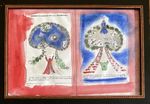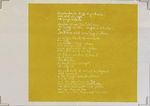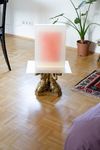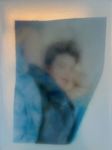Angela Stiegler / I treat my friends as sculptures
←
→
Page content transcription
If your browser does not render page correctly, please read the page content below
Françoise Heitsch • Amalienstrasse 19 • 80333 München
Angela Stiegler / I treat my friends as sculptures
Insister is the name Jacques Derrida gave to his long-time friend, dialogue partner,
and echo chamber Hélène Cixous. She had some name for him too. They worked
together and also wrote about each other, always mirroring the other’s work. You like
to say that bohemistic research requires a similar background in a shared
environment, within a specific individual diversity which is nevertheless built on a
divided basis, similar problems, and similar challenging experiences, which have to
be overcome or simply identified, to start with. Biographically speaking, this did
apply to Derrida and Cixous. We often work with each other, less strongly about each
other.
I do always make those videos of you though, which we gladly call biopic, while
neither of us really know what they’re meant to be. Something that does not seem to
bother you at all. You have been working directly with your environment for a long
time; maybe even as a kind of in-sister within a tight family network. The sister and
the insister, the persister, the defender. The concept of struggle was ever-present in
your work Anti Körper. Still, this struggle is not based on violence, but contact. And
conflict is based on proximity, not unfamiliarity. This idea of struggle shaped the
performance, which turned out distinctly physical; yet, it also influenced the various
negotiation processes, which were crucial for the performance’s development during
seven consecutive days. Struggle as contact. You protect and keep forms and
meaning permeable, which should and will effectively find their place within the
process, precisely because this place is not yet occupied. The Insistiererin, the
Tiererin, the Tier1, to open up, after Derrida, identity as a container. Through
exchange with others, objects and practices will emerge. These often find their
function in the next step, in dialogue, contact, or in transformations. The works
evolve in a biotope together with their companions, which have no clearly defined or
assigned roles. They never stand alone and are always looking for companionship.
There is a molecular interest in these companions, in these friends, which in form of
point clouds, on paper or set in soap, permeate the works as antibodies.
Soap is not as toxic as epoxy resin, it is cheaper than polyurethane, it is transparent, it
removes bacteria. It enters a fight. The disappearance, the decomposition, the silent
aggressiveness of the soap causes fear. In this fear stand, barely moveable, eight
kilos on their pedestals; they embody the struggle in object-form. They lead a silent
independent life, which, indeed, contains the delicate colour particles, while these
continue to exist in permanent uncontrollable flux. Thus, the pedestals actually
embrace a process that is able to mask itself as an object only to some extent. The
pedestals are an elevation and thus also become a superelevation of the idea of
1 Approximately: insister - animaliser - animal
Tel. +49 89 481200 • fheitsch@francoiseheitsch.de • www.francoiseheitsch.deFrançoise Heitsch • Amalienstrasse 19 • 80333 München
closure. Looked at it in that light, the soap does not have an aggregate state; its goal
is to disappear through its usage. The intrinsic open-ended process can no longer be
controlled despite all attempts at its fixation. Interventions and interferences of any
sort would entail a fundamental change in the form. Personal relationship processes,
which are equally difficult to control, become sculptures and actively insert
themselves formatively into the work. Not only do you treat your friends as
sculptures, they also intervene sculpturally in your work. Coming from their private
spaces, the pedestals become carriers and support this new biotope.
The works therefore also mark a place, physical and imaginary. A house is not
necessarily a home2 , but these sculptures are also dwellings for friendships. Residenz
and Reformhaus give these biotopes a space, a crumbly and bubbly home.
Yulia Lokshina
2“This house is not a home” - K 2020, exhibition title of the artist initiative K at Lothringer 13 Halle,
Munich
Tel. +49 89 481200 • fheitsch@francoiseheitsch.de • www.francoiseheitsch.deGalerie Françoise Heitsch • Amalienstrasse 19 • 80333 München
WERKLISTE / LIST OF WORKS
ANGELA STIEGLER / I TREAT MY FRIENDS AS SCULPTURES
19.11.2020 – 29.01.2021
Karin
Text, Acryl, Buttermilch auf
Schaufenster, Maße variabel,
Angela Stiegler, 2020
Edition Reformhaus
Prints: 60 × 40 × 1 cm, UV-
Druck hinter Acrylglas • UV
print behind acryl glass, Photo:
Constanza Meléndez, Auflage
• edition: 5 + 1AP, Angela
Stiegler, 2020
Preisliste auf Anfrage / Pricelist on Request
Tel. +49 89 481200 • fheitsch@francoiseheitsch.de • www.francoiseheitsch.deGalerie Françoise Heitsch • Amalienstrasse 19 • 80333 München
Reformhaus (Le Reformhaus Reformhaus (Gossip)
nouveau monde (Wohnzimmer/
amoureux) Schlafzimmer)
Reformhaus (Auto) Reformhaus (Life) Reformhaus
(Schlafender)
Reformhaus
Skulptur • sculpture:
40 × 30 × 7 cm,
Tintenstrahldruck in
Gießseife • inkjet
print in glycerin
soap, Angela
Stiegler, 2020
Reformhaus Reformhaus
(Elektrastraße) (Marianna)
Tel. +49 89 481200 • fheitsch@francoiseheitsch.de • www.francoiseheitsch.deGalerie Françoise Heitsch • Amalienstrasse 19 • 80333 München
Residenz
1) 70x100cm 13) 170x25cm
Installation, 24- 2) 60x130cm 14) 126,5x25cm
teilig, Punktwolke, 3) 110x130cm 15) 50x25cm
UV-Druck hinter 4) 25x130cm 16)126,5x25cm
Acrylglas • UV 5) 50x130cm 17) 50x56,5cm
print behind acryl 6) 25x130cm 18) 70x81,5cm
glass, Auflage • 7) 110x130cm 19) 100x25cm
edition: 2 + 1AP, 8) 60x130cm 20) 100x56,5cm
Angela Stiegler, 9) 170x25cm 21) 100x25cm
2020 10) 25x25cm 22) 100x56,5cm
11) 50x70cm 23) 70x81,5cm
12) 25x25cm 24) 170x45cm
Tel. +49 89 481200 • fheitsch@francoiseheitsch.de • www.francoiseheitsch.deGalerie Françoise Heitsch • Amalienstrasse 19 • 80333 München
Modell (Karin), 30 x 42,5 cm, Text, Modell (Beethoven Was a Lesbian),
Acryl hinter Glas, 2020 30 x 40 cm, Text, Tintenstrahldruck
(Pauline Oliveros mit Alison Knowles),
Acryl hinter Glas, 2020
Immunorchester Abbildung 1 und 2, Immunorchester Abbildung 3 und 4,
31 x 41 cm, Aquarell auf Tintenstrahl- 31 x 41 cm, Aquarell auf Tintenstrahl-
druck (Donna Haraway), 2020 druck (Donna Haraway), 2020
Immunological Orchestra Plate 3 and 4, Immunological Orchestra Plate 5 and 6,
24 x 33,5 cm, Aquarell, Nagellack, 24 x 33,5 cm, Aquarell, Nagellack,
Pastelkreide, Glitzer auf Tintenstrahldruck Pastelkreide, Glitzer auf Tintenstrahldruck
(Donna Haraway), 2020 (Donna Haraway), 2020
Tel. +49 89 481200 • fheitsch@francoiseheitsch.de • www.francoiseheitsch.deYou can also read



























































